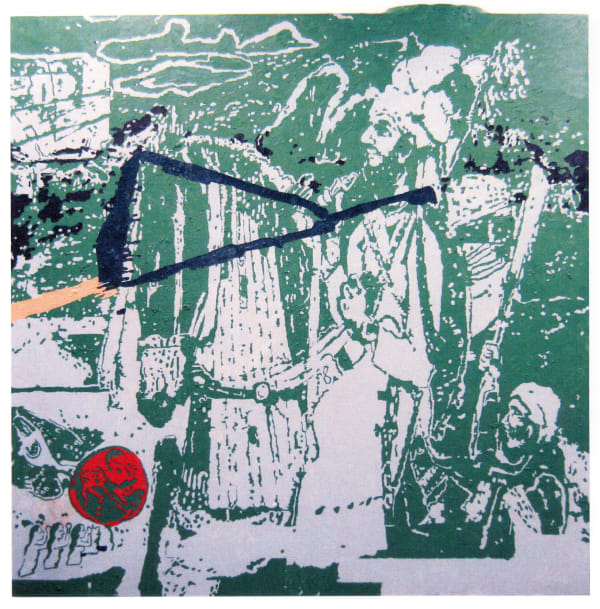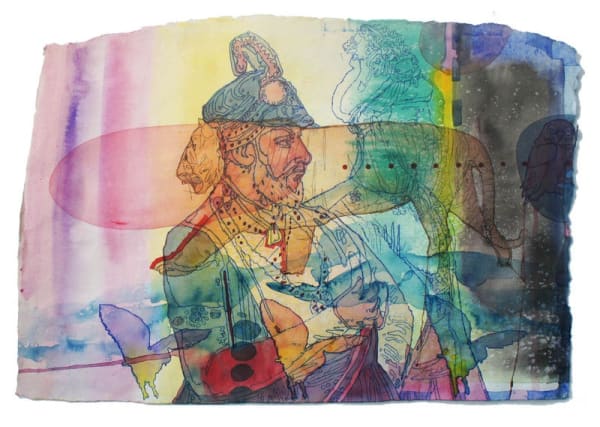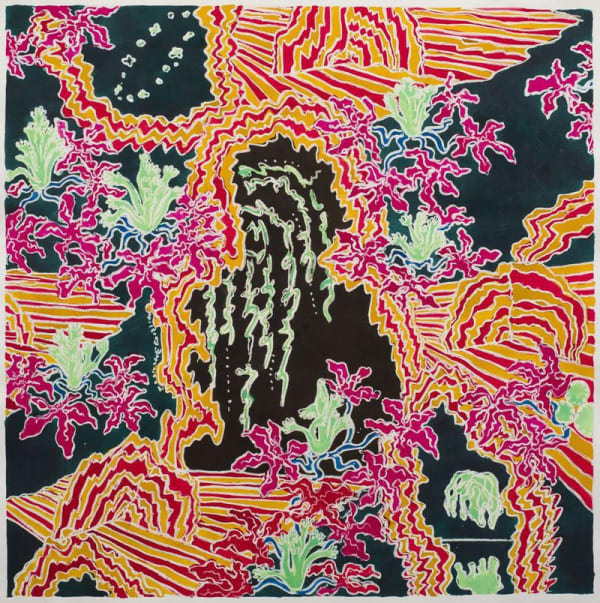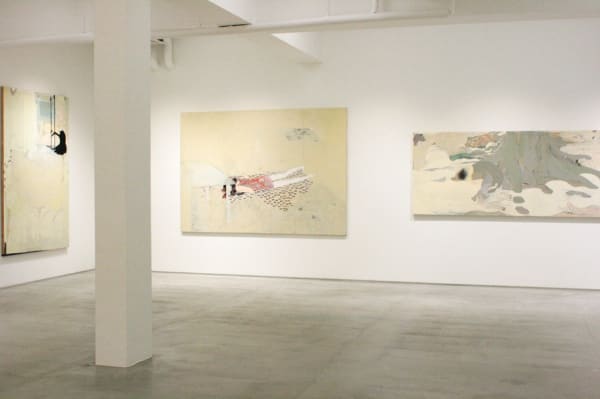Firoz Mahmud's works often draw artistic themes from the history of the Bangladeshi region in which he is deeply rooted, and where many historical cities have been transformed by colonialism. A distinct number of Mahmud's works look at Uponibeshik (colonial) and Poruponibeshik (post-colonial) narratives of Bangladesh and its capital city of Dhaka which was formerly known as Jahangir Nagar.
Mahmud coined the term 'Layapa Art' to describe his paintings that employ a technique that he researched on during a residency program at Rijksakademie VBK, Amsterdam in 2003/2004. The word 'Layapa' is from the Bengali language and means 'to anoint or plaster'. The women of rural Bangladesh use a meticulous technique to finish the walls of their village huts with clay. The artist sought inspiration from this as well as other cultural practices such as the Japanese Ukiyo-e woodblock printing. The end result is a hybridized stencil and layering technique which forms part of the foundation of Mahmud's art practice. Such aspects of cultural heritage may have gotten devalued or undermined through the mechanisms of colonialism that affected many nations from the 17th to the 20th centuries.
Mahmud's works are largely informed by his ongoing interest in historical narratives and artistic devices in story-telling. He uses idioms such as old palaces, forts, spice trees or herbaceous plants, wild animals and colonial traders in these drawings and carvings, addressing the riches of his native land. Mahmud juxtaposes themes of socio-political culture, tradition, history, and myths that beg the question of how they exist today, and what forces have created new visual territories, impacting how we remember our own cultural histories and those of our neighbours.
Firoz Mahmud (b. 1974) was born in Khulna, Bangladesh and completed his BFA and MFA at the Dhaka University's Institute of Fine Arts before attaining a PHD in Fine Arts from the Tokyo University of the Arts. He has completed residencies at the Rijksakademie VBK, Amsterdam, and the International Studio and Curatorial Program in New York. Mahmud’s paintings and installations examine the socio-political culture, tradition, history, myths and pop culture of his native land. His most notable works have been featured in group exhibitions at “HEAT” Ota Fine Arts, Tokyo (2017); “The Missing One” The Office for Contemporary Art Norway, Oslo, Norway (2016); "Aichi Triennale 2010: Arts and Cities", Aichi, Japan (2010); "The 9th Sharjah Biennial" Sharjah, UAE (2009); and "The 11th International Cairo Biennale" Cairo, Egypt (2008).
-
 Firoz MahmudFrom the series "Kahini", 2017Mixed media on handmade paper85.5 x 64 cm
Firoz MahmudFrom the series "Kahini", 2017Mixed media on handmade paper85.5 x 64 cm -
 Firoz MahmudPrince, 2011Oil on shaped canvas (stencil technique)131.5 x 194
Firoz MahmudPrince, 2011Oil on shaped canvas (stencil technique)131.5 x 194 -
 Firoz MahmudFat Boys ('sucker wfp21' project), 2011fighter aircraft, bean, glue variable dimensions, set of 5pieces
Firoz MahmudFat Boys ('sucker wfp21' project), 2011fighter aircraft, bean, glue variable dimensions, set of 5pieces -
![Firoz Mahmud, Traitor of Faith [Plot #1 Shiraj & Mir], 2010](data:image/gif;base64,R0lGODlhAQABAIAAAAAAAP///yH5BAEAAAAALAAAAAABAAEAAAIBRAA7) Firoz MahmudTraitor of Faith [Plot #1 Shiraj & Mir], 2010Oil on shaped canvas182.5 x 278 cm
Firoz MahmudTraitor of Faith [Plot #1 Shiraj & Mir], 2010Oil on shaped canvas182.5 x 278 cm -
![Firoz Mahmud, Traitor of Faith [Plot #2 Shiraj & Mir], 2010](data:image/gif;base64,R0lGODlhAQABAIAAAAAAAP///yH5BAEAAAAALAAAAAABAAEAAAIBRAA7) Firoz MahmudTraitor of Faith [Plot #2 Shiraj & Mir], 2010Oil on shaped canvas230 x 300 cm
Firoz MahmudTraitor of Faith [Plot #2 Shiraj & Mir], 2010Oil on shaped canvas230 x 300 cm -
 Firoz MahmudBrazen Whip, 2008Oil on shaped canvas186.5 x 182.2 x 4.8 cm
Firoz MahmudBrazen Whip, 2008Oil on shaped canvas186.5 x 182.2 x 4.8 cm -
 Firoz MahmudMajestic Cut (Green), Majestic Cut (Red), 2008Oil on shaped canvasLeft: 167 x 130 cm Right: 167 x 130 cm
Firoz MahmudMajestic Cut (Green), Majestic Cut (Red), 2008Oil on shaped canvasLeft: 167 x 130 cm Right: 167 x 130 cm
-

Firoz Mahmud: Drawing Reverberation
Firoz Mahmud 16 Nov 2018 - 5 Jan 2019 SingaporeOta Fine Arts Singapore is delighted to present Drawing Reverberation , a solo exhibition featuring paintings, drawings and wood carving works made in recent years by artist Firoz Mahmud ....Read more -

HEAT
Gallery's collection exhibition 13 May - 24 Jun 2017 TokyoIn this collection show, we introduce Asian artists who are gaining increasing attention in recent years. With bold imaginative motifs and intensive use of color, these works strike the viewers...Read more -

Imagined Peripheries
Masanori Handa, Yayoi Kusama, Firoz Mahmud, Nobuaki Takekawa, Yeesookyung 23 Nov - 24 Dec 2016 SingaporeOta Fine Arts Singapore is delighted to present 'Imagined Peripheries', a group exhibition by 5 artists from East Asia: Masanori Handa (Japan), Yayoi Kusama (Japan), Firoz Mahmud (Bangladesh), Nobuaki Takekawa...Read more -

Vivid Strata: New Representations of Asia II
Yayoi Kusama, Jia Aili, Firoz Mahmud, Qin Qi, Nobuaki Takekawa, Baek Jin Sook and Yeesookyung 22 Aug - 11 Oct 2014 SingaporeOta Fine Arts is delighted to present 'Vivid Strata: New Representations of Asia II', a summer group exhibition featuring a host of artists who are at the forefront of shaping...Read more -

Vivid Strata: New Representations of Asia
Firoz Mahmud, Rina Banerjee, Takao Minami, and Tomoko Kashiki 21 Jun - 21 Jul 2013 SingaporeThis summer, Ota Fine Arts is delighted to present a group exhibition featuring four contemporary artists from Asia all working in various strands of figurative representation, by means of painting,...Read more -

Lamentation in Two Lies
Firoz Mahmud 16 Apr - 4 Jun 2011 TokyoOta Fine Arts is pleased to announce the first solo exhibition of Firoz Mahmud, the artist who participated in Aichi Triennale last year. The exhibition is featuring Layapa paintings series...Read more -

New Address, New Works
Ay Tjoe Christine, Jay Flores Ticar, Firoz Mahmud, Manami Koike, Nobuaki Takekawa, Monir Farmanfarmaian, Yee Sookyung 18 Feb - 2 Apr 2011 TokyoOta Fine Arts is delighted to announce the gallery will return to Roppongi and new exhibition will start on 18th February. The group show, titled 'New Address, New Works' will...Read more -

When you switch off your mobile, painting starts to talk eloquently.
Manami Koike, Tomoko Kashiki, Firoz Mahmud 7 Jun - 12 Jul 2008 TokyoRead more
-

Firoz Mahmud
"Surface and Space: Works by Artists of the South Asian Diaspora", Alexey von Schlippe Gallery of Art, University of Connecticut, Avery , USA 7 Sep 2023Firoz Mahud will participate in a group exhibition titled 'Surface and Space: Works by Artists of the South Asian Diaspora' at Alexey von Schlippe Gallery...Read more -

Firoz Mahmud
"Inscaping Legacies", Pace University Art Gallery, New York, USA 7 Sep 2023Firoz Mahmud will be having a solo exhibition 'Inscaping Legacies' at Pace University Art Gallery, New York from 30 September to 28 October 2023. Title:...Read more -

Firoz Mahmud
"Echoes from New York!", Lurf Museum, Tokyo, Japan 3 May 2023Firoz Mahmud will participate in the group exhibition 'Echoes from New York!' at Lurf Museum, Tokyo from 3 May to 12 June 2023. Title: “Echoes...Read more -

Firoz Mahmud
"Firoz Mahmud: Early Episodes II", NJCU Visual Arts Gallery, New Jersey, USA 21 Jan 2023Firoz Mahmud will hold a solo exhibition, 'Firoz Mahmud: Early Episodes II' at NJCU Visual Arts Gallery in United States from 2nd February to 16...Read more




![Firoz Mahmud, Traitor of Faith [Plot #1 Shiraj & Mir], 2010](https://artlogic-res.cloudinary.com/w_600,c_limit,f_auto,fl_lossy,q_auto/artlogicstorage/otafinearts/images/view/df9b3f89b8969bd4f4278a1208ae31a6j/otafinearts-firoz-mahmud-traitor-of-faith-plot-1-shiraj-mir-2010.jpg)
![Firoz Mahmud, Traitor of Faith [Plot #2 Shiraj & Mir], 2010](https://artlogic-res.cloudinary.com/w_600,c_limit,f_auto,fl_lossy,q_auto/artlogicstorage/otafinearts/images/view/88edfcb5080e3e9f337db0593ce0d311j/otafinearts-firoz-mahmud-traitor-of-faith-plot-2-shiraj-mir-2010.jpg)















